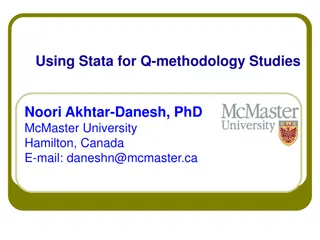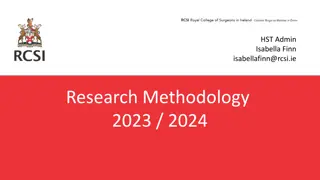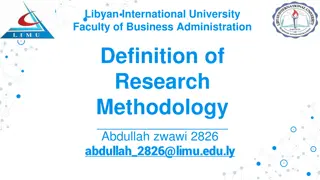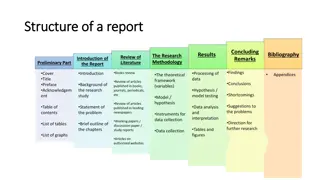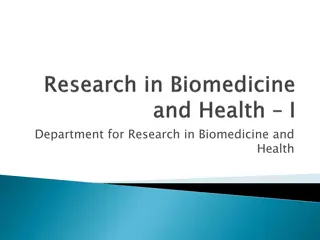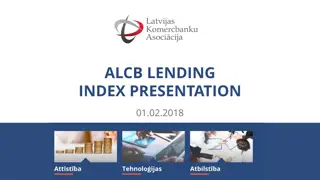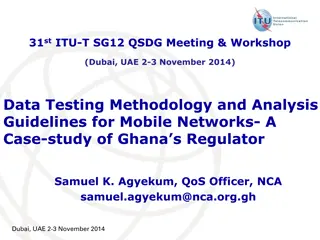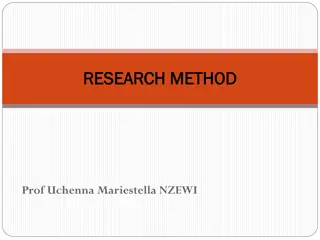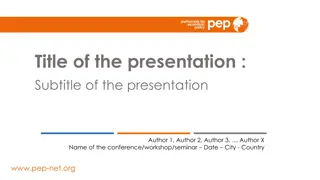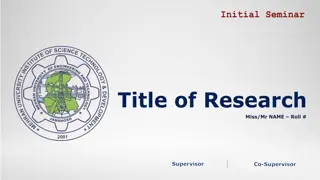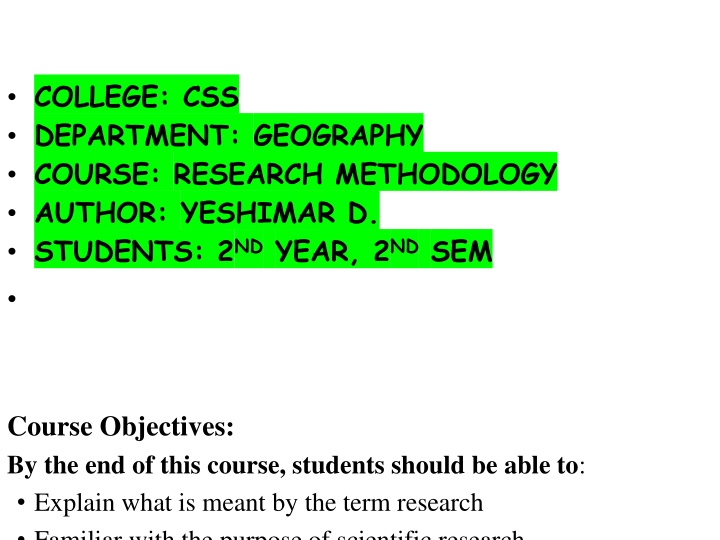
Exploring Advanced Research Methods in Environmental Management
This course in advanced research methods focuses on the application of research methodologies in natural resources and environmental management. Students will learn about scientific research purposes, research processes, ethical considerations, and data analysis techniques. The course covers problem identification, hypothesis formulation, sampling methods, and various research instruments. Emphasis is placed on understanding the choice of research methodology and developing practical research skills through hands-on experience with different analytical methods.
Download Presentation

Please find below an Image/Link to download the presentation.
The content on the website is provided AS IS for your information and personal use only. It may not be sold, licensed, or shared on other websites without obtaining consent from the author. If you encounter any issues during the download, it is possible that the publisher has removed the file from their server.
You are allowed to download the files provided on this website for personal or commercial use, subject to the condition that they are used lawfully. All files are the property of their respective owners.
The content on the website is provided AS IS for your information and personal use only. It may not be sold, licensed, or shared on other websites without obtaining consent from the author.
E N D
Presentation Transcript
COLLEGE: CSS DEPARTMENT: GEOGRAPHY COURSE: RESEARCH METHODOLOGY AUTHOR: YESHIMAR D. STUDENTS: 2NDYEAR, 2NDSEM Course Objectives: By the end of this course, students should be able to: Explain what is meant by the term research Familiar with the purpose of scientific research
identify basic principles and limitations of several research methods based on which critically analyze the various research outputs select appropriate research method and instruments for applications in environmental resources management issues; prepare research designs management context using observation, PRA(focus groups) and others; Process, and analyze the quantitative and/or qualitative methods, interpreting the results, and write the research reports understand the ethical consideration of research in the environmental interviews, surveys, collected data using
Course Description: The course in advanced research methods which deals with the use and application of research methods on natural resources and environmental management techniques in combination with other research methods used by other scholars/experts. Definitions of research, purpose of scientific research, development of scientific research, major research themes in environmental management, and types of research will be addressed. Distinguishing various research processes such as problem identification and formulation, articulation of research objective, hypothesis, or research questions, conceptualization, operationalization, population and sampling will be main focuses.
The course will explore in detail the choice of research methodology, emphasizing the selection of research methods and instruments problems/questions typically to be investigated within the field. Students will experiment with a range of analytical methods from both qualitative perspectives, and a variety of instruments including surveys, experimental, case studies, action research, participant observation, focus groups, interviews, and textual/document analysis. Data processing, data analysis, and reporting the results and assessing the implications will be treated. Within this context, the dev t of theory and the ethics and politics of research will also be examined. appropriate to research and quantitative
CHAPTER 1: INTRODUCTION TO RESEARCH METHODS 1.1. The Meaning of Research 1.2. The Development of Scientific Research Method 1.3. The Purpose of Scientific Research 1.4. Major Research themes in Environmental Studies CHAPTER 2: TYPES OF RESEARCH 2.1. Fundamental or Basic Research 2.2. Applied Research 2.3. Conclusion Oriented Vs. Decision Oriented Research 2.4. Hierarchy Class of Research 2.5 Diagnostic, Theoretical and Evaluative Research 2.6. Quantitative vs. Qualitative 2.7. Conceptual Vs. Empirical
CHAPTER 3: RESEARCH PROCESSES AND RESEARCH DESIGN 3.1. The Research Process 3.1.1. Selection of a Research Problem (Topic) 3.1.2. Literature Survey 3.1.3. Stating the Research Problem 3.1.4. Formulating the research objective 3.1.5 Articulating Research Hypotheses 3.1.6. Choosing Variables to Study 3.2. Research Design 3.2.1. Meaning of Research Design 3.2.2. Types of Research Designs and Approaches 3.2.3. Criteria for Evaluation of Research 3.2.4. Research Ethics
Chapter 4: Sample Design 4.1. Basic Concepts 4.2. Why sample? 4.3. Probability sampling 4.3.1. Simple random sampling 4.3.2. Stratified random sampling 4.3.3. Cluster sampling 4.4. Non-probability sampling 4.4.1. Convenience sampling 4.4.2. Snowball sampling 4.4.3. Quota sampling
CHAPTER 5: HOW TO REVIEW THE LITERATURE 5.1. Uses of the Literature Review 5.2. Problems of Reviewing Literature 5.3. Components of A literature 5.4. Processes in Reviewing Literature CHAPTER 6: MEASUREMENT STRATEGIES& DATA COLLECTION 5.1. Nature of Environmental Data 5.2. Measurement in Research 5.3. Scales of Measurement 5.4. Measurement Strategies for Data Collection 5.5. Sources of Data 5.6. Methods of Data Collection
CHAPTER 7: DATA PROCESSING, ANALYSIS AND INTERPERTATIONS 6.1. Nature and Purpose of Data Analysis 6.2. Data Analysis Steps 6.3. Interpretation of the Results 6.4. Drawing Conclusions and Recommendations CHAPTER 7: RESEARCH REPORT WRITING 7.1. Research Reports and Classifications 7.2. The Structure of Research Report (Contents) 7.3. General Remarks on Style and Presentation
Course Instruction Modes The course will be imparted using lecture; The session provides opportunity to discuss, obtain feedback, and; workout assignments to apply the skills covered in the lectures; also serves as a forum for discussion of readings targeted issues of environmental management and related assignments.
Course Requirements and Responsibilities You should take the responsibility to complete the reading assignments before the lecture; Successful completion of this course require regular class attendance, and thorough reading of all assigned materials; Three requirements for the course are: One project assignment, a mid-term test and a final exam; grade components that comprise the course The assignment guidelines will be distributed and discussed; The guideline will explain the assignment and the criteria to be used in evaluation in detail.
1. Introduction to Research Methods 1.1. Meaning of Research The term research was derived from the French word recherech , to search closely; Literally means investigating thoroughly. The term consists of two words: Research = re + search Re means again and again and search means to find out something. Therefore, research means to observe the phenomena again and again from different dimensions. Research is the process of collecting the data based on which the researcher draws some conclusions.
Research knowledge, discovery, or creative activity in an area with the goal of advancing a given area. An art of scientific investigation for knowledge. self-directed work individually; research means: investigate something you do not know or understand; an academic activity and the term should be used in a technical sense; involves an entire collection of information is the scholarly pursuit of new
Research as scientific method is composed of the following key elements:- EmpiricalApproach is the scientific method with an evidence-based approach through direct observation and; experimentation in the acquisition of new knowledge up on which scientific decisions are made; Observations composed of two distinct concepts: being aware of the world around us making careful measurements important component in any scientific investigation; often give rise to the questions addressed through scientific research.
Questions: Research process involves translating that research idea into an answerable question; follows getting a research idea based on observations of the world around us; It is essential to formulate a research question that can be answered through available scientific methods and procedures; an unanswerable research question is the following: Is there an exact replica of me in another universe? research question can be answered as example, one might ask, whether drought reduces crop yield; This question could be researched and answered using established scientific methods
Hypotheses the next step in the scientific method; it is simply an educated and testable guess about the answer to your research question. Experiments involves conducting the experiment (or research study); follows articulating the hypothesis; e.g. involving investigating the effects of chemical fertilizers on crop yield, the researcher would design experiment and conduct a study that would attempt to address that question; In this e.g, the researcher would collect data by experimenting on chemical fertilizers by using an accurate and reliable measurement device; Then the researcher can analyze the impacts of fertilizers on crop yield and livelihood basis.
Analyses in analyzing the data, calls for the use of statistical techniques follows gathering the data; The type of statistical techniques used depends on the design of the study, the type of data being gathered, and; the questions being asked. statistics help to minimize the likelihood of reaching an erroneous conclusion about the relationship b/n variables. Conclusions draw some conclusions about the results of the study; important to draw conclusions supported by the data analyses. Replication most important elements of the scientific method; conducting the same research study a 2nd time with another group of participants if same results are obtained by same researcher perhaps other researchers may undertake that task.
Checking the generalizablity of the results to other groups of research participants; If the results of a study are replicated, the researchers and the field in which he/she works can have greater confidence in the reliability and generalizablity of the original findings. 1.2. The Development of Scientific Research Method Roger Bacon, a philosopher and scientist from 13th century England argue that the Italian scientist Galileo Galilei played an important role in formulating the scientific method. Later contributions to the scientific method were made by the philosophers Francis Bacon and Ren Descartes.
1.3. The Purpose of Scientific Research Discover new facts and understand the reality Verify and test important facts Describe the characteristics of an individual, situation or a group; Analyze an event or process or phenomenon to identify the cause and effect relationship between variables Develop new scientific tools, concepts and theories to understand & solve problems Improve theories and revise human knowledge on different aspects Find solutions to scientific, nonscientific and social problems Overcome or solve the problems occurring in our every day life. Acquire new knowledge via the application of scientific methods
What Makes People do Research? Desire to get a research degree along with its benefits like better employment, promotion, increment in salary, etc. to get a research degree and then to get a teaching position in a college or university or become a scientist in a research institution to get a research position in countries and settle there Desire to solve the unsolved and challenging problems of society Desire to get intellectual joy of doing some creative work to acquire respectability and to get recognition curiosity to find out the unknown facts of an event curiosity to find new things to serve the society by solving social problems. to gain familiarity with a phenomenon or to achieve new insight into it Desire to resolve contradictions existing in the area of study.
1.4. Major Research themes in GeES/Environment The Spatial Analysis/Locational theme Ecological Analysis/Human ecology theme Regional Analysis/Regional complete theme Earth Science Theme/earth science tradition (1) Spatial Analysis Theme/ Locational Theme This theme is primarily concerned with location and distribution of significant properties in space; answering the wherequestions or spatial distribution of a single or set of physical or human phenomena.
The Spatial Analysis/ Locational Theme Contd The study on human phenomena include: distribution and density of population, rural poverty, cotton cultivation, and leather and shoe factory. Natural phenomena include: patterns of temperature, rainfall, vegetation, animals, soils, water resources, wetlands, and other inanimate objects; Factors and processes governing the distribution and location of phenomena (i.e. finding locational pattern). This theme has developed into d/t stages & times. For instance, before 1950s locational factors were discussed in the context of absolute location and distance; But as of 1950 s the case has been changed to deal with relative location, distance, and space.
Spatial Analysis theme (contd) Enables researchers to develop the skill of finding optimum location of human activities and; to help understanding of natural phenomena. Helps to understand and find out whether the distribution of phenomena is good or bad helps to overcome locational or spatial problems Enables researchers to make: more generalizations and to build more theories; e.g., to develop hypothesis on how agricultural developments distribute around the world.
2. Ecological Analysis/Human ecology theme Its main concern is with the reciprocal relationship b/n man and the environment (nature) and ; consequences up on each (human & Env t); It was studied throughout the history of geography but was more emphasized as a research theme after the theory of evolution by Charles Darwin (1859); The theme integrates physical and human elements; Concentrates: human attention into environmental problems like pollution, erosion, degradation, etc.
3. Regional Analysis Theme/ Regional Complete Theme describe significant regional characteristics (not on single phenomena); It identifies and defines the arrangements of phenomena within a given region; Regions are identified based on certain contexts (landform, vegetation, rainfall, temperature, etc); Lacks problem-oriented focus and structure which can be boring. In its best, it integrates: both the spatial and ecologicalanalyses with in the defined region and; a careful thorough synthesis of regional characteristics.
Chapter Two: Types of Research 2.1. Basic Research investigate basic principles and reasons for occurrence of a particular event or process or phenomenon; also known as pure or fundamental or theoretical research; related to pure science; primarily aim to improve theoretical knowledge or understand the logical process and fundamental characteristics of physical and human environments; Promote the theoretical understanding of the relationship among variables; mainly concerned with generalizations with the formulation of a theories and a laws. It may also verify the old theories
Basic research (contd) directed towards finding information that has a broad base of application and thus, adds to the already existing organized body of scientific knowledge; It is essentially positive, not normative to explain the phenomena as they are, not as they should be; not concerned with solving any practical social and environmental problems of immediate interest; the outcome of such research provides the foundation for many applied research.
B. Applied research solves certain problems employing well known and accepted theories and principles Its results are used with reference to the phenomena. Links basic research methods into practical situations. its central aim is to discover solutions for urgent practical problems facing societies. involves normativepolicy prescription and hence incorporates some value judgments. can test theories empirically for improving tools & techniques. applied research is empirical and practical; Examples of this research type: experimental research, case studies and inter-disciplinary research.
2.2. Conclusion Oriented Vs. Decision Oriented Research A. Conclusion-oriented research derived by the researchers curiosity and intuition. the researchers are free to select their research problem and; methods to investigate according to their interest. aims at making conclusions after investigation. It can also be applied or basic research; e.g. establishing careful definition of educational methods; selection of valid and reliable outcome measures; and; use of sound experimental designs; identify barriers to meet program, and; identify methods for overcoming; e.g. identify useful guidelines for the extension agents to promote the effectiveness of the extension program
B. Decision-oriented research is intended to be the bases for decision-making process. the topics are selected by decision-makers; the researchers have no right to select their research topics; research topics have to be chosen among the given list of topics of an institution intended to be conducted; it is geared towards solving the problem of decision- makers it is more of applied research.
2.3. Hierarchy Class(ladder) of Research 4 levels in the hierarchy of research and; each level precedes one after the other although exception exists. A. Descriptive research Such kinds of research describe essential characteristics of a phenomenon to know it well. surveys comparative, Correlational methods and fact-finding enquiries of different kinds. The major purpose : description of the state of affairs as it exists at present; give a detailed account of: a particular issue, person or process emphasizing on what , where and when questions; no control over the variables, he can only report what has happened & observed.
thus it is essential to have detailed knowledge of things. not explain the influence or impact of certain factors in the event on which it is focusing. applicable with a more historical subject with no attention to how and why questions. considered as a basic level of research for further explanation and prediction. B. Explanatory searching explanations for events & phenomena; for example:- finding answer to the question why are the things like what they are? the focus shifts in to how and why questions and; require explanation of the r/hip b/n variables, for example:- explaining the r/ship b/n: - vegetation & rainfall;altitude & vegetation; altitude & temperature, etc.
C. Predictive Research Prediction - accurate deduction (inference) on observation of events not made yet. is based on tested theories or laws; e.g.weather forecasting, population projection, production projection, vulnerability projection, etc. e.g. Meteorologists may attempt to predict weather; a prediction is being made based on existing knowledge of something else. D. Prescriptive research Implies statement or question concerning to:- what should be done to attain certain goals or; to solve problems based on sound knowledge rather than whatis or what will be . It is normative and some how decision-oriented research.
2.4. Diagnostic, Theoretical and Evaluative Research A. Diagnostic research identify the problems to be studied for the future; an estimation of the probability of the presence of a particular problem; So as to decide then treatment should be initiated or not B. Theoretical research related to articulation of theories (e.g. articulating env'tal research). C. Evaluative research the systematic assessment of the operation and/or the outcomes of a program or policy; such kinds of research contribute to the improv't of the program or policy; determine the adequacy or achievements and failures of human action relative to the predetermined policies and plans; also tries to assess the nature of the env t before and after human actions. For e.g, mining, agriculture, industry, etc
2.5. Quantitative vs. Qualitative Quantitative research based on the measurement of quantity Some of the characteristics of quantitative research method are: It is numerical, non-descriptive, applies statistics and uses nos. It is an iterative process whereby evidence is evaluated. The results are often presented in tables and graphs. It is conclusive (beyond question). It investigates the what , where and when of decision making. is the most widely used branch of mathematics in quantitative research; applied in physical & social sciences, economics, & biology. begins with the data collection based on a theory or hypothesis or experiment followed by: Applying descriptive or inferential statistical methods.
Qualitative research study qualitative phenomenon characterized by: non-numerical, descriptive, applies reasoning and uses words. aim to get the meaning, feeling and describe the situation. cannot be graphed. exploratory & investigates the why and how of decision making. concerned with qualitative phenomenon aims at discovering the underlying motives and desires, using in depth interviews. Attitude or opinion research research designed to find out how people feel or what they think about a particular subject or institution is also qualitative research. important in the behavioral sciences to discover the underlying motives of human behavior. analyze the various factors motivate people to behave in a particular manner or make people like or dislike a particular thing. However, applying qualitative research in practice is relatively difficult; hence, one should seek guidance from experimental psychologists.
2.6. Conceptual Vs. Empirical Conceptual related to some abstract idea(s) or theory; is generally used by philosophers & ; source of origin to develop new concepts or to reinterpret existing ones. Empirical relies on experience or observation alone, often without due regard for system and theory. It is data-based research, coming up with conclusions which are capable of being verified by observation or experiment; also known as experimental type of research Enable to get firsthand facts, at their source, and; actively to go about doing certain things to stimulate the production of desired information. is appropriate when proof (verification) is required that certain variables affect other variables in some way; today considered to be the most powerful support possible for a given hypothesis.
CHAPTER 3: RESEARCH PROCESS AND DESIGNS 3.1. Research Processes: inter-related methodological steps researchers follow as a guideline. (1) Selection of a research topic (2) Definition of a research problem (3) Extensive literature survey and reference collection (4) Assessment of current status of the topic chosen (5) Formulation of hypotheses (6) Preparing the research design (7) determining sample design (8) Actual investigation/Data collection (9) Data analysis and hypothesis testing (10) Generalizations and Interpretation of result (11) Preparation of the report or presentation of the results
3.1.1. Selection of a Research Problem Deciding what to study. Sensing research problem for investigation. start with the felt problems/ felt needs of the society. Research problem-a question researchers try to find answers. identifying feasible problem though most difficult step especially for the beginners up on w/c the secret for the success of research depends; Researchers choose the topics for which their decisions are necessarily influenced by many factors.
Where do we get research ideas? The scientific field within which the researcher works Experience of others: Colleagues/advisors - We can share experiences from others with personal or friendly discussions. Reading publications: we can get research topics by reading different literature such as: books, journal articles, periodicals and bulletin; By reading them some gaps could be identified the researcher next can pick it up for further research in order to fill these identified gaps. Contradictory Findings: to find out some differentiations, a researcher may explore the controversial area of research. Faulty Methodology: the methods that we employ will kill or save our research and hence would influence to arrive at right findings and reasonable conclusions. Shortcoming of theories: D/t writers have formulated d/t theories with their weaknesses and positive sides in representing environmental realities.
The topic of research may take into account:- the existing information gap in various theories, and; accordingly, the researcher may choose his topic so that the information gap is minimized. Research can be conducted to suggest an alternative and better theory or analysis. For example, Malthus s population theory had been sources for criticizing, correcting or modifying it by his followers Conferences/seminars, television/radio programs Program priorities Funding agencies Training and Experience Observation: Many researchers become interested in particular research ideas simply by observing the world around them. we can observe certain problems in our work places, in the residential areas, and travelling, that happened to strike our mind; As a result, we may ask ourselves why this is happened. so, pick it up as a research topic
(9) Previous research experiences Researchers also choose topics based on the results of prior research, whether conducted by them or someone else. For e.g, a sociologist who primarily studies the socialization of adolescents may take an interest in studying the related phenomenon of adolescent criminal behavior after being exposed to research studies on that topic. In these instances, researchers may attempt to: replicate the results obtained by the other researchers; or perhaps extend the findings of the previous research to different populations or settings. A large portion of research stems from researchers efforts:- to build upon, expand, or; re-explain the results of previously conducted researches.
Research title must be tested before further research: Is the topic of current interest? thus it should be selected well from the burning problems of the time. Do the results have educational, social and scientific values? Do I have the knowledge and skill to complete the project? Assess whether you can do it- any technical challenges? Do I have enough motivation & energy to complete the project? Are facilities available for me? Administrative, data, computer, etc. Do I have enough funds to complete the project? Do I have enough time to complete the project? Are there ethical problems or limitations? Is the topic repeatable? The question of repeatability research shouldn t be the first and the last. You should see some are following you.
How to make our research title interesting?Titles should: 1. Capture the readers interest: don t use plain words instead use words stimulate readers interests. Hence necessary to read d/t materials and consult experienced people. 2. be specific, concise, descriptive & clear 3. State the functional r/ships of variables: dependent & independent variables 4. Should be correctly ordered: first and less important things should come in its vital order Recurring drought and its impact on the env t recurring drought is more important than the env t. Environmental impacts of recurring drought environment is more important than recurring drought 5. Try to use a single sentence or try to shorten long sentences by using colon (:) e.g. Climate Variability and Agriculture in Ethiopia: Impacts, Vulnerability, and Adaptation
3.1.2. STATING A RESEARCH PROBLEM Once the topic for research is selected, the problem to be studied should be clearly defined - ready to clearly articulate the research problem. It is the problem which guides our research. However, every problem is not a scientific research problem. E.g. - Is there an exact replica of me in another universe? - Is there really satan in my home area?
The best way of presenting research problem is in interrogative statements b/se research problem is a question for which the researchers seek to find answers for unsolved problem. Examples of research problems include: (1) Is the onset of drought related to deforestation? (2) What effect does flood on the farmers of the Fogera plain has? (3) What is the perception of farmers on climate change? (4)Can env l education for farmers improve their awareness on problems? Good research problems must meet the following criteria. It should describe the r/ship between two or more variables. Research problem must not be too broad or too narrow the research problem should take the form of a question. must be capable of being tested empirically (i.e., with data derived from direct observation and experimentation).
3.1.3. Formulating the research objective stated based on the problems under study (general specific objectives); The general objective - the overall deriving force of the research ; the specific objectives set to achieve the general objectives must be clear and concise, to the point and brief. The general objective could be: To identify, describe and analyze the interacting factors influencing the distribution of grain farming on the Ethiopian highlands. Based on this objective, specific objectives could be to:- examine the probability of factors influenced the distribution of grain farming; Identify factors influencing affecting distribution of grain farming. To describe factors influence the distribution of grain farming.
3.1.4 Articulating Research Hypotheses one of the most important steps in the research planning process. attempt to explain, predict, and explore the phenomenon of interest and the r/ship b/n two or more variables. researcher s imagined idea or educated guess about how the study will turn out; It should be logically stem from the research problem being investigated; is a tentative generalization based on the accumulated previous knowledge to be tested hence they are not final answers; If the exact result is known, no need of conducting research. may or may not be proved right; On the basis of the hypothesis, facts are observed and collected, when by verification, the hypothesis is found to be true, a theory is obtained. expressed usually in declarative statements, they must be expressed explicitly (unambiguously); Research problem and hypothesis are two sides of a coin.
They provide the r/ship b/n variables as characterized from spatial and temporal point of view; For example, hypotheses provide the r/ship b/n intensity of rainfall and soil erosion keeping other factors constant. Functions of Hypothesis explain all the facts connected with the problem enables us to guide the course of the research along the right lines through suggesting experiments and observations It limits the scope of enquiry to a manageable area distinguish relevant and non-relevant data thus leads to economy of time and money. It can apply analytical works regression, correlation, etc. essential to develop generalizations and theories in most researches It leads to significant conclusions for advancing knowledge. But all research problems may not be amenable to formulation of testable hypothesis.


